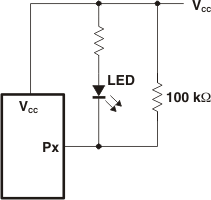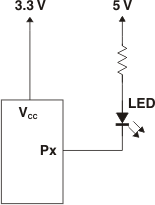ZHCSFH3A September 2016 – February 2023 TCA6408A-Q1
PRODUCTION DATA
- 1 特性
- 2 应用
- 3 说明
- 4 Revision History
- 5 Pin Configuration and Functions
- 6 Specifications
- 7 Parameter Measurement Information
- 8 Detailed Description
- 9 Application and Implementation
- 10Device and Documentation Support
- 11支持资源
- 12Mechanical, Packaging, and Orderable Information
9.2.1.2 Minimizing ICC When I/O is Used to Control LEDs
When the I/Os are used to control LEDs, normally they are connected to VCC through a resistor as shown in GUID-4D38174B-449A-4391-9732-FEAC63A5C0EF.html#SCPS2348238. The LED acts as a diode, so when the LED is off, the I/O VIN is about 1.2 V less than VCC. The ΔICC parameter in the GUID-C28FBBDC-9725-4E28-82C3-3AC80EAD8B8D.html#GUID-C28FBBDC-9725-4E28-82C3-3AC80EAD8B8D table shows how ICC increases as VIN becomes lower than VCC. Designs that must minimize current consumption, such as battery power applications, must consider maintaining the I/O pins greater than or equal to VCC when the LED is off.
#SCPS2343321 shows a high-value resistor in parallel with the LED. #SCPS2341867 shows VCC less than the LED supply voltage by at least 1.2 V. Both of these methods maintain the I/O VIN at or above VCC and prevent additional supply current consumption when the LED is off.
 Figure 9-2 High-Value Resistor in Parallel With LED
Figure 9-2 High-Value Resistor in Parallel With LED Figure 9-3 Device Supplied by a Low Voltage
Figure 9-3 Device Supplied by a Low Voltage